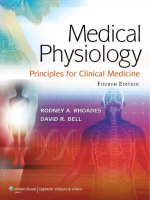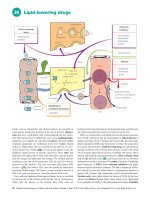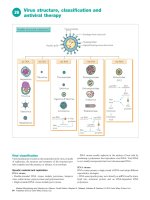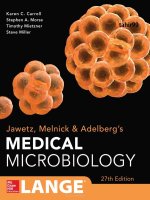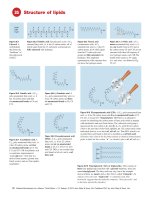ophthalmology ebook Medical
Bạn đang xem bản rút gọn của tài liệu. Xem và tải ngay bản đầy đủ của tài liệu tại đây (1.13 MB, 92 trang )
LECTURE NOTES
For Health Science Students
Ophthalmology
Dereje Negussie, Yared Assefa, Atotibebu Kassa, Azanaw Melese
University of Gondar
In collaboration with the Ethiopia Public Health Training Initiative, The Carter Center,
the Ethiopia Ministry of Health, and the Ethiopia Ministry of Education
2004
Funded under USAID Cooperative Agreement No. 663-A-00-00-0358-00.
Produced in collaboration with the Ethiopia Public Health Training Initiative, The Carter
Center, the Ethiopia Ministry of Health, and the Ethiopia Ministry of Education.
Important Guidelines for Printing and Photocopying
Limited permission is granted free of charge to print or photocopy all pages of this
publication for educational, not-for-profit use by health care workers, students or
faculty. All copies must retain all author credits and copyright notices included in the
original document. Under no circumstances is it permissible to sell or distribute on a
commercial basis, or to claim authorship of, copies of material reproduced from this
publication.
©2004 by Dereje Negussie, Yared Assefa, Atotibebu Kassa, Azanaw Melese
All rights reserved. Except as expressly provided above, no part of this publication may
be reproduced or transmitted in any form or by any means, electronic or mechanical,
including photocopying, recording, or by any information storage and retrieval system,
without written permission of the author or authors.
This material is intended for educational use only by practicing health care workers or
students and faculty in a health care field.
PREFACE
This lecture note will serve as a practical guideline for the hard-pressed mid-level
health workers. We hope that it will be a good introduction to eye diseases for health
science students working in Ethiopia.
There are so many books about eye diseases available but hardly any, which are
written from the perspective of Ethiopia, where more blind are live.
The lecture note is basically focused on the community as well as clinical
ophthalmology to introduce the students on the common causes and burden of
blindness and their preventive aspect. So it is written for students who are intended
to see patients and need to recognize each disease and recommend possible
treatment. When looking at a patient with eye disease, the most important skill is to
be able to recognize the appearance of each particular disease.
In the management of diseases which are beyond their scope are recommended to
refer as early as possible. They shouldn’t urge to start to manage such patients at
their level. Their main role is to pick problems early and to have an active role in the
prevention of blindness. Selected pictures are used to illustrate some anatomical
parts and common eye diseases to make note easier and understandable.
There are several encouraging signs that there is an increasing awareness of the
challenge of treatable and preventable blindness throughout the world. Our country
is forming prevention of blindness to try to look realistically at the problem locally.
NGO’s and the government are highly devoted to treat and prevent major cause of
blindness in the country specially cataract and trachoma.
In spite of all this, the number of avoidably blind people in Ethiopia continues to
increase faster than the population.
i
ACKNOWLEDGEMENT
The development of this lecture note has gone through series of individual works,
writing and revisions. We would like to express our appreciation to The Carter
Center, Atlanta Georgia for funding the activities in the development of this lecture
note all the way through.
We would like to thank Gondar University for helping us with different material in
order to make this note feasible.
Reviewers that highly contributed to the development of this material using their
valuable time and experience include
1. Dr. Yonas Tilahun, Assistant Professor in Ophthalmology, AAU-MF.
2. Dr. Yilikal Adamu, Honorary Assistant Professor in Ophthalmology,
AAU-MF
3. Dr. Yeneneh Mulugeta, Assistant Professor in Ophthalmology, Jimma
University
4. Dr. Zeki Abdurazik, Assistant professor in Surgery, Gondar University
At last but not least we would like to convey special appreciation for the finalization
of the material at National reviewer level by using his valuable time
Dr. Abebe Bejiga , Associate professor in ophthalmology , AAU-MF
ii
TABLE OF CONTENTS
TOPIC
PAGE
PREFACE ............................................................................................................. i
ACKNOWLEDGEMENT ...................................................................................... ii
TABLE OF CONTENT ....................................................................................... iii
LIST OF FIGURES AND COLOR PLATES ......................................................... iv
LIST OF TABLES ................................................................................................. v
ABBREVIATION AND ACRONYMS ................................................................... vi
INTRODUCTION .................................................................................................. 1
UNIT ONE
BASIC ANATOMY AND PHYSIOLOGY OF THE EYE ...... ………………. 3
UNIT TWO
BASIC EXAMINATION OF THE EYE ...................................................... 17
UNIT THREE
EXTERNAL EYE DISEASES .................................................................... 28
UNIT FOUR
DIFFERENTIAL DIAGNOSIS OF RED EYE ............................................ 35
UNIT FIVE
COMMUNITY OPHTHALMOLOGY ......................................................... 45
UNIT SIX
EYE INJURIES ......................................................................................... 67
UNIT SEVEN
SYSTEMIC DISEASE AND THE EYE ...................................................... 71
APPENDIX ......................................................................................................... 78
REFERENCES ................................................................................................. 81
iii
3. LIST OF FIGURES AND COLOR PLATES
Figure
1.1: The structure of the eye lids and conjunctiva
Figure
1.2: The lacrimal apparatus
Figure
1.3: Components and origin of tear film
Figure
1.4: The basic structure of the eye to show its three layers
Figure
1.5: Enlarged views of the angle of anterior chamber
Figure
5.1: Refraction in normal eye
Figure
5.2: Refraction in a myopic eye
Figure
5.3: Refraction in a hypermetropic eye
Figure
5.4: Refraction by an astigmatic eye
Color plate .1. Pterygium
Color plate .2. Corneal foreign body
Color plate .3. Mature cataract
Color plate .4.Mild trachoma with follicle and papilla
Color plate .5. Severe trachoma with follicle and papilla
Color plate .6. Moderate trachoma with follicle and papilla
Color plate .7. Large follicle and papilla
Color plate .8. Conjunctival scarring in the upper conjunctiva
Color plate .9. Corneal vascularization with scar
Color plate .10. Acute iridocyclitis
Color plate .11. Bitot’s spots with conjunctival xerosis
Color plate .12. Blepharitis
Color plate .13. Penetrating eye injuries with scleral laceration
Color plate .14.Bacterial conjunctivitis
Color plate .15. Keratitis
Color plate .16. Congenital glaucoma
Color plate .17. Left exotropia
Color plate .18. Ophthalmic Herpes Zoster
iv
List of tables
Table 1.1: Revision of extra ocular muscle innervations and their actions
Table 4.1: Summary of Differential Diagnosis of red eye
Table 5.1 strategies in the treatment of trachoma
Table 5.2: Recommended dose of vitamin A for age >one year or weight >8kgs
Table 5.3 Recommended dose of vitamin A for age
v
5. Abbreviation and acronyms
AIDS
- Acquired Immune Deficiency syndrome
CF
-Counting finger
CMV
- Cytomegalovirus
CN
-Cranial nerve
CO
- Corneal opacity
ELISA
- Enzyme linked immuno sorbent assay
HM
- Hand motion
HIV
- Human immune deficiency virus
IOP
-Intra ocular pressure
LP
-Light perception
NLP
- No light perception
OD
- Oculus Dexter( right eye)
OS
- Oculus Sinister (left eye)
OU
- Oculus unita (both eye)
TF
- Trachomatous follicle
TI
-Trachomatous intense
TOD
- Tension of Oculus Dexter
TOS
- Tension of Oculus Dexter
TS
- Trachomatous scarring
TT
- Trachomatous trichiasis
V/A
- Visual acuity
VOD
- Vision of Oculus Dexter
VOS
- Vision of Oculus Sinister
vi
INTRODUCTION
The eye is the most amazing and complex structure in the body .The two
eyes provide about half the total sensory input from the entire body into the
brain. The eye is sensitive to trauma, infection or inflammation that may end
up in blindness. Just as the blind spot is neglected by the brain, about
45million people in the world who are blind are largely neglected by medical
science and technology, and by the caring professionals; of this 80% is
preventable. The situation in Ethiopia is similar with prevalence of blindness
being about 1.5% and an estimated around 1.05 million blind people.
.Blindness has, directly or indirectly, social as well as economical impact. The
causes are multifactorial. In order to address these multifactorial causes, all
rounded and effective approach is needed.
Above all there are few ophthalmologists and other ophthalmic workers in
relation to population. So the need for skilled man- power that will involve
specially at preventable level is undoubted. For this, problem oriented training
is mandatory in order to overcome ophthalmic health problems in the country.
The care taker should be aware of its sensitivity. This can be done by early
management at the first level of health institute or by appropriate referral
There are many reference books about ophthalmic diseases but most are not
written with regard to our country’s situation where most blind people live. To
alleviate this problem, Ophthalmology Department of Gondar University has
got a full support from carter center. Thus, this teaching material was
prepared. It was tried to focus on common ophthalmic problems and major
causes of blindness so that this document will serve as a practical guideline
for mid-level health workers. The lecture note will give the students pertinent
knowledge and practice about prevention of blindness. It contains seven
chapters.
1
Each chapter contains:
1. Objectives at the beginning of the chapters which are intended to guide
the students in their study.
2. The body with detail notes
3. Exercises related to it and suggested references.
2
UNIT ONE
BASIC ANATOMY AND PHYSIOLOGY OF THE EYE
1.1
PROTECTION OF THE EYE
1.2
THE EYE BALL
1.3
BLOOD SUPPLY, LYMPHATIC DRAINAGE AND INNERAVATION OF
THE EYE
1.4
EXTRA OCULAR MUSCLES
Objective
1. To give a clear description on the anatomy and physiology of the eye.
2. Having the basic idea will help to have a better understanding on the
pathology of specific part of the eye.
3. At the end of this course, students are expected to know basic
anatomy and physiology of the eye.
1.1.
THE PROTECTION OF THE EYE
A - Eye Lids
It has the following parts
I. Skin - has three important features
-
Thinnest, more elastic and mobile than skin else where in the
body
-
Little or no subcutaneous fat under the skin makes it a good
source of skin graft
-
Has an extremely good blood supply that is why wound
heals well and quickly.
II. Muscles
Orbicularis oculi muscle
•
Important for closure of eye lid
3
•
Innervated by facial (7th cranial) nerve
Levator Palpebrae
•
Elevator of eye lid.
•
Innervated by Oculomotor (3rd cranial) nerve
Muller’s muscle
•
Help to retract the upper eye lid
•
Innervated by cervical sympathetic nerve.
III. Tarsal plates
- Are composed of dense fibrous tissue
-Keep the eye lids rigid and firm
-Contain meibomian glands, which open at lid margin, and
makes oily secretion that forms a part of corneal tear film.
B. Conjunctiva
It is a thin mucous membrane which lines the inner surface of the eye lid and
outer surface of the eye ball.
The main function of the conjunctiva is to protect the cornea.
¾ During opening and closure of the eyelids, it lubricates the cornea with
tears.
¾ The conjunctiva also protects the exposed parts of the eye from
infection because it contains lymphocytes and macrophages to fight
infections.
¾ Mucin from goblet cells has wetting effect of tear film
It has three parts:
I. Tarsal Conjunctiva
- The part lining in the inner aspect of the eye lid
- Firmly attached to the underlying tarsal plate
II. Bulbar Conjunctiva
- The part lining the eye ball
- Loosely attached to the underlying sclera
4
III. Fornix
-Part in which the tarsal and bulbar conjunctivas are continuous.
The conjunctival epithelium is continuous with the corneal epithelium at the
margin of the cornea, which is called limbus. Conjunctiva contains many small
islands of lymphoid tissue especially in the fornix.
Gray line is a mucocutaneous junction of the skin and conjunctiva.
Frontal bone
Levator Palpebrae
Orbicularis
muscle
Conjunctival fornix with
Accessory lacrimal
glands
Skin
Tarsal conjunctiva
Eyelashes
Tarsal plate
with meibomian
glands
Fig 1.1. The structure of the eyelids and conjunctiva
Skin
C.LACRIMAL APPARATUS
- Consists of
•
Lacrimal gland
•
Punctum
•
Canaliculi
•
Nasolacrimal sac
•
Nasolacrimal duct
5
Lacrimal apparatus produces and drain tears that forms component of tear film
Lacrimal
gland
Punctum
Canaliculus
ducts
Lacrimal sac
Nasolacrimal
duct
Common Canaliculus
Fig 1.2. The Lacrimal apparatus.
-The tear forms a thin film of fluid on the surface of the conjunctiva and cornea,
which is vital for the health, and transparency of the cornea.
¾ Outer part( Lipid layer)- oily secretion from meibomian and Zeis gland
¾ Middle part(Aqueous layer)-Water from Lacrimal gland and accessory
lacrimal glands of Krause and Wolfring.
¾ Inner part(Mucin layer)-Mucus from goblet cells of the conjunctiva
Function of tear film.
1-provides moist environment for the surface epithelial cells of the
conjunctiva and cornea
2- Along with the lids, it washes away debris
3- Transport metabolic products (oxygen, carbon dioxide) to and from
the surface cells
4- Antimicrobial actions
5- Provides a smooth refracting surface over the cornea
6
Lipid layer
Aqueous layer
Mucin layer
Fig. 1.3. Components of tear firm
D-
ORBITAL BONES
The orbit is formed by seven bones and has four walls.
Wall of orbitRoof
Frontal bone and sphenoid bone
Floor
Zygomatic, maxillary and palatine bones
Medial
Ethimoid, frontal, Lacrimal and sphenoid bones
Lateral
- The strongest of all walls.
Zygomatic and sphenoid bone
1.2- THE GLOBE /EYE BALL/
The globe is a visual organ which weighs 7.5 gm and has an average diameter of
24mm.
- Has three coats
I- Outer coat/ fibrous/- sclera and cornea.
II- Middle layer/vascular/- iris, ciliary body, choroids
III- Inner layer/neural/- sensory retina and pigment epithelium.
7
- Has three ocular chambers
I- Anterior Chamber
II- Posterior Chamber
III- Vitreous Space
-Associated structures (Adnexa)
- Eye lids with all its parts, extra ocular muscles, Vessels, nerves, lacrimal
apparatus, adipose and connective tissues.
Sclera
Retina
Anterior
Chamber
Choroid
Cornea
Fovea
Optic
nerve
Pupil
Lens
Suspensary
ligament
Iris
Optic nerve
head
Ciliary body
Conjunctiva
Vitreous body
1.4. The basic structure of the eyeball to show its three layers.
1.2-1 FORM AND FUNCTIONS OF THREE OCULAR COATS
A-
THE OUTER COAT
I. Sclera
-
Means tough.
-
Is an opaque and thick coat made of collagen fibers.
8
-
Is poorly vascularized but is sandwiched between the
highly vascularized episclera and choroid.
-
The metabolic requirements are met by diffusion.
-
Constitutes the posterior 5/6 th of the globe.
-
important to protect and keep the shape of the globe
-
Is the main refractive media of the eye (75 % of
II. Cornea
refractory function of the eye).
-
Avascular but obtains its metabolic needs from the
vessels of limbus and aqueous fluid, and oxygen from
atmosphere.
-
Thickness varies from 0.5mm centrally to 1 mm
peripherally.
-
Has very rich sensory nerve supply from ophthalmic
branch of trigeminal nerve.
It has three layers
a)
Surface epithelium
.5 or 6 cells thick, of non keratinized stratified Squamous
epithelium.
Continuous with conjunctival epithelium
Constantly changing or shedding.
b)
The inner stroma
- Main bulk of cornea /accounts for 90% of corneal thickness
- Has two additional membranes
I-
Bowman's membrane is special support of
surface epithelium.
II-
Descemet's membrane is tough support of
endothelium.
c)
Inner surface (endothelium)
-Single layer of very active cuboidal cells.
-Transfers fluid out of the stroma and keep the cornea
dehydrated.
- can’t regenerate but can expand to adjust damaged cell
9
B. THE MIDDLE LAYER
-Consists of the iris, ciliary body and choroid.
-They are continuous with one another and are collectively
known as the uveal tract (uvea Latin word means grape).
1. Iris
- has central hole (pupil) through which light reaches the
retina
- consists of a vascular stroma covered by mesothelium
anteriorly and by two pigmented layers of epithelium
posteriorly.
-It is continuous with the ciliary body
- has smooth (involuntary) muscle.
- It has two muscles
I)
The sphincter pupillae
- Located in the pupillary zone with breadth of 1mm
- Innervated by parasympathetic fibers
- Stimulation of the muscle causes constriction of the
pupil (miosis)
II)
The dilator pupillae
- Extends radially from the ciliary body to the
sphincter muscle.
- Innervated by sympathetic fibers
- Stimulation causes pupillary dilatation (mydriasis).
N.B the pupil is never at rest. Its size is subject to various factors like aging,
illumination, sleep, change of gaze, emotional status.
2.
Ciliary body
-
Triangular structure that is situated between the iris
anteriorly and choroids posteriorly.
-
Has
I) ciliary process- site of aqueous fluid production.
ii) Ciliary muscle- important for accommodation(When it contracts lens become more round in shape
and the zonular ligament become loosen then increased
focusing power to make clear near vision).
10
-
Attached to the lens with suspensory ligament
and helps to keep it in it’s position.
Circulation of aqueous fluid
Aqueous fluid is produced by ciliary process of ciliary body. It flows from the
posterior Chamber along the pupillary opening to the anterior chamber. Finally
it will be drained through the Canal of schlemn in the Trabecular meshwork to
episcleral veins
Endothelium
Stroma
Epithelium
Trabecular
meshwork
Canal of
Schlemn
Iris
Anterior
Chamber angle
Lens
Posterior chamber
Ciliary Processes
Ciliary body
Fig.1.5 Enlarged view of the angle of the anterior chamber.
3.
The Choroids
-
It is network of blood vessels
-
The arteries and veins are located externally while capillaries are
found internally.
-
Is responsible for the blood supply of the outer half of the retina.
-
It has pigment cells that absorb light to prevent unwanted reflection.
11
C.THE INNER COAT- RETINA
-
Thin, transparent, net like membrane with a high rate of oxygen
metabolism.
- Consists of two kinds of photoreceptors.
Cones- color & bright light sensitive cells that are found toward the center.
Rods- sensitive to dim lights that are found peripherally.
These are antennae of visual system i.e. react with light and light energy
is transformed into a visual perception.
Have two layers
I-
Outer layer
- Next to choroid, single layer of fragment epithelial cell.
- Contains rods and cones.
- Avascular and gets its nutrition from choroid by diffusion.
II-
The Inner Layer
- Consists of bipolar and ganglion cells as well as nerve fibers and
synapses.
- Light passes through this to reach rod and cones.
¾ This produces electrical impulses when they are exposed to light. The
electrical impulses produced by each rod or cone passes across
synapses to the bipolar cell. Then the impulses are modified in various
ways as they pass through the bipolar and ganglion cells. The nerve
fibers from the ganglion cells travel in the nerve fibers layer on the
surface of the retina to the optic disc and form the optic nerve.
Two important parts of the retina
1.Macula Lutea
- Point of sharpest vision and color vision
- About 1.5 mm in diameter and is located two disc diameter
temporal to optic disc
- It appears darker than the rest of retina
- Yellows spot (fovea) is a depression at the centre of the macula
and shines during ophthalmoscopy. (Foveal reflex).
12
The yellow color is due to the presence of carotenoid pigment (xanthophylls).
This is used to protect the macular cones from the dazzle of incident light, which
occurs even with maximal pupillary constriction.
- Visual acuity varies depending on the concentration of cone . Foveal
vision is 1.0(20/20) as you move away from it V/A decreases.
- It is the center of visual axis.
2-Blind spot
- Is an area of complete blindness in the visual field.
- Anatomically it corresponds to optic nerve head, which is located nasally
and measure 1.5 mm in diameter.
- At this point, there are no photoreceptors.
1.2.2. THE CHAMBERS OF THE GLOBE
A.
Anterior chamber
- Delineated anteriorly by the posterior corneal surface and
posteriorly by iris.
- Depth- 3-4 mm
- Volume of aqueous humor in the anterior chamber is about 0.25 ml
- Inflow and outflow are balanced so that the entire contents of
anterior chamber are replaced every 10 hrs.
B.
Posterior chamber
-
Limited anteriorly and laterally by the posterior iris surface and
ciliary body and posterior by lens & vitreous body
C.
Vitreous space
- Filled with vitreous humor
- Transparent, roughly spherical and gelatinous structure
occupying posterior 4/5 of the globe with volume of 4 ml.
- Consist of water (99 %), collagen, hyaluronic acid and soluble
protein.
- Inert
-Function: - to act as intervening medium in the light pathway
between the lens and retina and also gives the shape of the eye.
13
1.2.3. THE LENS
- Consist of closely packed transparent cells enclosed in a capsule.
- Has unique feature
-
Transparent
-
No blood or nerve supply.
-
Has higher protein content than other body tissues.
-
Continues to grow through out life, new in the top, old
compressed to ward the centre.
-
The only solid structure inside the eye.
-
Has biconvex shape.
-
Epithelial cells are not shedding type
-
Has three anatomical parts: capsule, cortex, nucleus
Its nutrition is maintained by the metabolic exchange between itself and the aqueous
humor.
1.3
BLOOD SUPPLY, INNERVATIONS AND LYMPHATIC
DRAINAGE OF THE EYE
1.3.1 Blood supply of the eye
A- Arterial blood supply
The eye is supplied by anastomosing vessels from internal and
external carotid arteries.
∗
Retina - inner layer gets blood from central retinal artery, a
branch of ophthalmic artery and enters the eye with optic
nerve and divides on the optic disc into its branches.
∗
Uvea - is supplied by ciliary circulation, from ophthalmic
artery.
∗
Eye lid gets its blood supply from facial and ophthalmic
arteries.
14
B- Venous Drainage
Almost the entire blood from the anterior and posterior uvea drains
through four vortex veins via superior and inferior orbital veins to
cavernous sinus.
Eye lid drains through facial vein into cavernous sinus
1.3.2. Lymphatic drainage
There are no lymphatic vessels inside the globe. The lymphatic drainage
of the medial eye lid is to sub mandibular lymph node and that of lateral
one is to the superficial preauricular lymph nodes and then to deeper
cervical lymph nodes.
1.3.3 Innervations of the eye
A- Motor
- Oculomotor (CN III) Innervate- medial rectus, superior rectus, inferior
rectus, & inferior oblique.
-Trochlear (CN IV) nerve- innervates superior oblique
-Abducent (CN VI) nerve- innervates lateral rectus.
- Facial nerve (CN VII) - innervates orbicularis oculi muscle
B- Sensory nerve
- Ophthalmic branch of trigeminal nerve is the sensory nerve of the
globe & adnexa and has three branches -frontal, lacrimal,
nasociliary.
- Optic nerve (CNII) - responsible for vision.
C- Autonomic nerves
I-
Sympathetic nerve- supplies Muller's muscles and dilator
pupillae.
II-
Parasympathetic comes via oculomotor and innervates the
ciliary muscle and sphincter pupillae.
1.4
EXTRA OCULAR MUSCLES
-
They are six, and their action is so complex.
-
Control eye movement
-
Form cone behind the eyeball
15
Table 1.1 Extra ocular muscles and their action (monocular action)
- Superior rectus
for upward movement of the eye
- Inferior oblique
inward and up ward movement of the eye
- Medial rectus
inward movement of the eye
- Lateral rectus
outward movement of the eye
- Inferior rectus
for downward movement of the eye
- Superior oblique
- inward and down ward movement of the of the eye
Exercise
1. What is unique character of skin in the eyelid?
2. What are the components of eyelid and their function?
3. Discuss about lacrimal apparatus, anatomical and physiological aspect.
4. List the middle layers of the eyeball with their function.
5. What is the difference between blind spot and fovea?
6. What are the unique features of the lens?
7. Discuss about the circulation of aqueous humor.
Reference
1- John sand ford – smith, Eye disease in Hot Climate c reed Educational and
professional publishing LTD, 1997
2 - Kanski clinical ophthalmology c reed Educational and professional
publishing LTD 1999
3 - Kenneth W.wright, A text Book of ophthalmology - E. Ahmed
4 - Albert and Jakoboiec Principle and practice of ophthalmology
5 - Up to date - (C) 2001 - www.up to date.com. (800) 998-6374.(781)237-4788
6 - D. Vaughan General ophthalmology
16
UNIT TWO
BASIC EXAMINATION OF THE EYE
2.1. HISTORY TAKING
2.2. TESTING VISION
2.3. EXAMINING THE EYE
Objective:
1. To give a clear idea about the approach to ophthalmic patients and
specific examination techniques.
2. To familiarize the students with certain ophthalmic instruments.
3. At the end of the course the students are expected to know how to
examine ophthalmic patients and use of certain ophthalmic instruments
2.1. HISTORY TAKING: History taking should follow this out line
1. Personal details
¾ Name
¾ Address
¾ Age
¾ Occupation
2. History of the present complaint
3. General health and any medication the patient may be taking
4. Past ophthalmic medical and surgical history
5. Family history
The main purpose of the history is to find out what exactly the patient is
complaining. However it is always helpful to find out some background
information about the patient e.g. age, sex, occupation, and literacy. Such
information will indicate what vision the patient needs for work and for personal
satisfaction.
17




